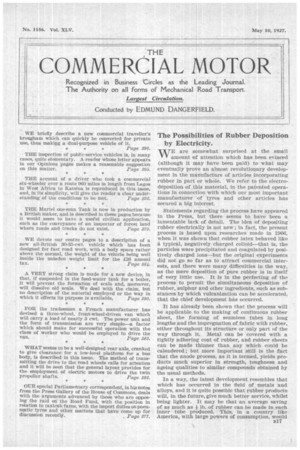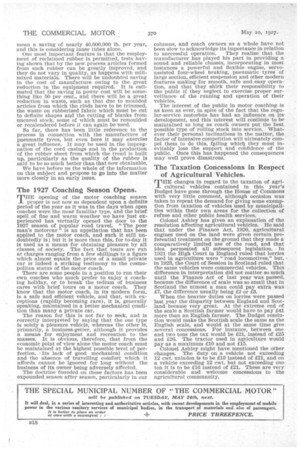The Possibilities of Rubber Deposition by Electricity.
Page 43

Page 44

If you've noticed an error in this article please click here to report it so we can fix it.
WE are somewhat surprised at the small amount of attention which has been evinced (although it may have been paid) to what may eventually prove an almost revolutionary development in the manufacture of articles incorporating rubber in part or whole. We refer to the electrodeposition of this material, in the patented operations in connection with which our most important Manufacturer of tyres and other articles has secured a big interest.
Statements regarding the process have appeared in the Press, but there seems to have been a lamentable lack of detail. The idea of depositing rubber electrically is not new ; in fact, the present process is based upon researches made in 1906, when it was shown that rubber latex behaved like a typical, negatively charged colloid—that is, the particles were precipitated and coagulated by positively charged ions—but the original experiments did not go so far as to attract commercial interests, and there were many difficulties in the way, as the mere deposition of pure rubber is in itself of very little use. It is in the perfecting of the process to permit the simultaneous deposition of rubber, sulphur and other ingredients, such as substances by which vulcanization can be accelerated, that the chief development has occurred.
It has already been shown that the process will be applicable to the making of continuous rubber sheet, the forming of seamless tubes in long lengths and the impregnation of fabric with rubber, either throughout its structure or only part of the way through it. Metal can be covered with a tightly adhering coat of rubber, and rubber sheets can be made thinner than any which could be calendered ; but more important still• is the fact that the anode process, as it is termed, yields products much superior in strength, toughness and ageing qualities to similar compounds obtained by the usual methods.
In a way, the latest development resembles that which has occurred in the field of metals and alloys, and it is quite possible that rubber products will, in the future, give much better service, whilst being lighter. It may be that an average saving of as much as lb. of rubber can be made in each inner tube produced. This, in a country like America, with large powers of consumption, would mean a saving of nearly 40,000,000 lb. per year, and this is considering inner tubes alone, One most important feature is that the employment of reclaimed rubber is permitted, tests having shown that by the new process articles formed from such rubber can be greatly improved, and they do not vary in quality, as happens with millmixed materials. There will be undoubted saving in the cost of manufacture owing to the great reduction in the equipment required. It is estimated that the saving in power cost will be something like 50 per cent., and there will be a great reduction in waste, such as that due to moulded articles from which the rinds have to be trimmed, the waste on rubberized fabric which must be cut to definite shapes and the cutting of blanks from uncured stock, some of which must be remoulded or recalendered before it can again be used.
So far, there has been little reference to the process in connection with the manufacture of pneumatic tyres, but even here it may exercise a great influence. It may be used in the impregnation of the cord casings and in the production of the rubber sheet from which the tread is built up, particularly as the quality of the rubber is said to be so much better than that now obtainable.
We have before us the whole of the information on this subject and propose to go into the matter more closely in an early issue.
The 1927 Coaching Season Opens.
THE opening of the motor coaching season proper is not now so dependent upon a definite period of the year as it was in the days when open coaches were the most familiar type, and the brief spell of fine and warm weather we have just experienced has virtually opened the door to the 1927 season of popular road travel. "The poor man's motorcar" is an appellation that has been applied to the motor coach, and such it still undoubtedly is ; but it is more than this, for to-day it Is used as a means for obtaining pleasure by all classes of society. The fact that tours are run at charges ranging from a few shillings to a figure which almost equals the price of a small private car is indeed a striking testimony to the cosmopolitan status of the motor coach.
There are some people in a position to run their own coaches who much prefer to enjoy a coaching holiday, or to break the tedium of business cares with brief tours on a motor coach. They know that the motor coach, in its modern form, is a safe and efficient vehicle, and that, with exceptions (rapidly becoming rare), it is, generally speaking, maintained in a better mechanical condition than many a private car.
The reason for this is not far to seek, and is correctly interpreted by saying that the one type is solely a pleasure vehicle, whereas the other is, primarily, a business-getter, although it provides a means for enjoyment and recreation to the masses. It is obvious, therefore, that from the economic point of view alone the motor coach must be maintained at the highest possible level of perfection. Its lack of good mechanical condition and the absence of travelling comfort which it affords cannot be ignored for long without the business of its owner being adversely affected.
The doctrine founded on these factors has been expounded season after season, particularly in our columns, and coach owners as a whole have not been slow to acknowledge its importance in relation to successful operation. They realize that the manufacturer has played his part in providing a sound and reliable chassis, incorporating in most instances a powerful and flexible engine, servoassisted four-wheel braking, pneumatic tyres of large section, efficient suspension and other modern features making for smooth, safe and easy operation, and that they shirk their responsibility to the public if they neglect to exercise proper surveillance of the running and operation of their vehicles.
The interest of the public in motor coaching is as keen as ever, in spite of the fact that the regular-service motorbus has had an influence on its development, and this interest will continue to be maintained so long as coach owners put the best possible type of rolling stock into service. Whatever their personal inclinations in the matter, the factor of intensive competition will ultimately compel them to do this, Wing which they must inevitably lose the support and confidence of the public. Once this has happened the consequences may well prove disastrous.
The Taxation Concessions in Respect of Agricultural Vehicles.
THE changes in regard to the taxation of agricultural vehicles contained in this year's Budget have gone through the House of Commons with very little comment, although occasion was taken to repeat the demand for giving some exemption from taxation of vehicles used by municipalities within their own areas for the collection of refuse and other public health services.
Colonel Ashley has given• an explanation of the resolution affecting agricultural vehicles. Re said that under the Finance Act, 1920, agricultural engines used on the land were given certain preferential treatment on the ground that they made a comparatively limited use of the road, and that idea permeated all subsequent legislation. In 1921 the High Court in England ruled that lorries used in agriculture were "road locomotives," but, in 1923, the Court of Session in Scotland ruled that the same vehicles were commercial vehicles. This difference in interpretation did not matter so much until the Finance Act of last year was passed, because the difference of scale was so small that in Scotland the utmost a man could pay extra was £7, the difference usually being £2 or 13.
When the heavier duties on lorries were passed last year the disparity between England and Scotland became very great. At the extreme end of the scale a Scottish farmer would have to pay £41 more than an English farmer. The Budget resolution would make the Scottish scale the same as the English scale, and would at the same time give several concessions. For instance, between one and two tons the tax would be £21, instead of £25 and £26. The tractor used in agriculture would pay as a maximum £10 and not £15.
Colonel Ashley might have mentioned the other changes. The duty on a vehicle not exceeding 12 cwt. unladen is to be £10 instead of £21, and on a vehicle exceeding 12 cwt. but not exceeding one ton it is to be L16 instead of 121. These are very considerable and welcome concessions to the agricultural coramunuity.




















































































































